ESP JEEP CHEROKEE 2020 Owner handbook (in English)
[x] Cancel search | Manufacturer: JEEP, Model Year: 2020, Model line: CHEROKEE, Model: JEEP CHEROKEE 2020Pages: 332, PDF Size: 8.87 MB
Page 75 of 332

73
Refer to “LaneSense — If Equipped” in
“Starting And Operating” for further informa-
tion.
— Park/Headlight On Indicator Light
This indicator light will illuminate when the
park lights or headlights are turned on.
— Stop/Start Active Indicator Light
This telltale will illuminate when the Stop/
Start function is in Autostop mode.
— Turn Signal Indicator Lights
When the left or right turn signal is activated,
the turn signal indicator will flash inde -
pendently and the corresponding exterior
turn signal lamps will flash. Turn signals can
be activated when the multifunction lever is
moved down (left) or up (right).
NOTE:
A continuous chime will sound if the
vehicle is driven more than 1 mile
(1.6 km) with either turn signal on.
Check for an inoperative outside light bulb
if either indicator flashes at a rapid rate.
White Indicator Lights
— Active Speed Limiter Ready Indicator
Light — If Equipped
This light will turn on when the Active Speed
Limiter is on, but not set.
/ — Adaptive Cruise Control (ACC)
Ready Light — If Equipped
This light will turn on when Adaptive Cruise
Control (ACC) has been turned on, but is not set.
Refer to “Adaptive Cruise Control” in “Starting
And Operating” for further information.
— Adaptive Cruise Control (ACC) Set
Light — If Equipped
This light will turn on when the vehicle
equipped with Adaptive Cruise Control (ACC)
has reached the speed desired and the set
button has been selected. Refer to “Adaptive
Cruise Control” in “Starting And Operating”
for further information.
— Hill Descent Control (HDC) Indicator
Light — If Equipped
This indicator shows when the Hill Descent
Control (HDC) feature is turned on. The lamp
will be on solid when HDC is armed. HDC can
only be armed when the transfer case is in
the 4WD LOW position and the vehicle speed
is less then 30 mph (48 km/h). If these
conditions are not met while attempting to
use the HDC feature, the HDC indicator light
will flash on/off.
— LaneSense Indicator Light — If
Equipped
When the LaneSense system is ON, but not
armed, the LaneSense indicator light illumi -
nates solid white. This occurs when only left,
right, or neither lane line has been detected.
If a single lane line is detected, the system is
ready to provide only visual warnings if an
unintentional lane departure occurs on the
detected lane line.
Refer to “LaneSense — If Equipped” in
“Starting And Operating” for further informa -
tion.
2020_JEEP_CHEROKEE_UG_RHD_UK.book Page 73
Page 80 of 332

SAFETY
78
Dynamic Steering Torque (DST)
Dynamic Steering Torque (DST) is a feature
of the Electronic Stability Control (ESC) and
the Electric Power Steering (EPS) modules,
that provides torque at the steering wheel for
certain driving conditions, in which the ESC
module is detecting vehicle instability. The
torque that the steering wheel receives is
only meant to help the driver realize optimal
steering behavior in order to reach/maintain
vehicle stability. The only notification the
driver receives that the feature is active is
the torque applied to the steering wheel.
NOTE:
The DST feature is only meant to help the
driver realize the correct course of action
through small torques on the steering wheel,
which means the effectiveness of the DST
feature is highly dependent on the driver’s
sensitivity and overall reaction to the applied
torque. It is very important to realize that this
feature will not steer the vehicle, meaning
the driver is still responsible for steering the
vehicle.
Electronic Brake Force Distribution (EBD)
The Electronic Brake Force Distribution
(EBD) function manages the distribution of
the braking torque between the front and
rear axles by limiting braking pressure to the
rear axle. This is done to prevent overslip of
the rear wheels to avoid vehicle instability,
and to prevent the rear axle from entering
ABS before the front axle.
Electronic Roll Mitigation (ERM)
The Electronic Roll Mitigation (ERM) system
anticipates the potential for wheel lift by
monitoring the driver’s steering wheel input
and the speed of the vehicle. When ERM
determines that the rate of change of the
steering wheel angle and vehicle’s speed are
sufficient to potentially cause wheel lift, it
then applies the appropriate brake and may
also reduce engine power to lessen the
chance that wheel lift will occur. ERM can
only reduce the chance of wheel lift occur-
ring during severe or evasive driving maneu -
vers; it cannot prevent wheel lift due to other
factors, such as road conditions, leaving the
roadway, or striking objects or other vehicles. NOTE:
ERM is disabled anytime the ESC is in “Full
Off” mode (if equipped). Refer to “Electronic
Stability Control (ESC)” in this section for a
complete explanation of the available ESC
modes.
WARNING!
Many factors, such as vehicle loading,
road conditions and driving conditions,
influence the chance that wheel lift or
rollover may occur. ERM cannot prevent all
wheel lift or roll overs, especially those
that involve leaving the roadway or striking
objects or other vehicles. The capabilities
of an ERM-equipped vehicle must never
be exploited in a reckless or dangerous
manner which could jeopardize the user's
safety or the safety of others.
2020_JEEP_CHEROKEE_UG_RHD_UK.book Page 78
Page 84 of 332

SAFETY
82
The gear selection must match vehicle
uphill direction (i.e., vehicle facing uphill
is in forward gear; vehicle backing uphill is
in REVERSE (R) gear).
HSA will work in REVERSE gear and all
forward gears. The system will not activate
if the transmission is in PARK (P) or
NEUTRAL (N). For vehicles equipped with
a manual transmission, if the clutch is
pressed, HSA will remain active.
Disabling And Enabling HSA
This feature can be turned on or turned off.
To change the current setting, proceed as
follows:
If disabling HSA using your instrument
cluster display, refer to “Instrument
Cluster Display” in “Getting To Know Your
Instrument Panel” for further information.
If disabling HSA using Uconnect Settings,
refer to “Uconnect Settings” in “Multi-
media” for further information.
For vehicles not equipped with an instru -
ment cluster display, perform the following
steps:
1. Center the steering wheel (front wheels pointing straight forward)
2. Shift the transmission into PARK (P)
3. Apply the park brake
4. Start the engine 5. Rotate the steering wheel slightly more
than one-half turn to the left
6. Push the “ESC OFF” button located in the lower switch bank below the climate
control four times within 20 seconds.
The “ESC Off Indicator Light” should
turn on and turn off two times
7. Rotate the steering wheel back to center and then an additional slightly more than
one-half turn to the right
8. Turn the ignition to the OFF mode and then back to ON. If the sequence was
completed properly, the “ESC Off Indi -
cator Light” will blink several times to
confirm HSA is disabled
9. Repeat these steps if you want to return this feature to its previous setting
WARNING!
There may be situations where the Hill
Start Assist (HSA) will not activate and
slight rolling may occur, such as on minor
hills or with a loaded vehicle, or while
pulling a trailer. HSA is not a substitute for
active driving involvement. It is always the
driver’s responsibility to be attentive to
distance to other vehicles, people, and
objects, and most importantly brake
operation to ensure safe operation of the
vehicle under all road conditions. Your
complete attention is always required
while driving to maintain safe control of
your vehicle. Failure to follow these
warnings can result in a collision or serious
personal injury.
2020_JEEP_CHEROKEE_UG_RHD_UK.book Page 82
Page 86 of 332

SAFETY
84
Activating HDC
Once HDC is enabled it will activate auto-
matically if driven down a grade of sufficient
magnitude. The set speed for HDC is select -
able by the driver, and can be adjusted by
using the gear shift +/-. The following
summarizes the HDC set speeds:
HDC Target Set Speeds
P = No set speed. HDC may be enabled
but will not activate.
R = 0.6 mph (1 km/h)
N = 1.2 mph (2 km/h)
D = 0.6 mph (1 km/h)
1st = 0.6 mph (1 km/h)
2nd = 1.2 mph (2 km/h)
3rd = 1.8 mph (3 km/h)
4th = 2.5 mph (4 km/h)
5th = 3.1 mph (5 km/h)
6th = 3.7 mph (6 km/h)
7th = 4.3 mph (7 km/h)
8th = 5.0 mph (8 km/h)
9th = 5.6 mph (9 km/h) – If Equipped NOTE:
During HDC the +/- shifter input is used for
HDC target speed selection, but will not
affect the gear chosen by the transmission.
When actively controlling HDC the transmis
-
sion will shift appropriately for the
driver-selected set speed and corresponding
driving conditions.
Driver Override
The driver may override HDC activation with
throttle or brake application at any time.
Deactivating HDC
HDC will be deactivated but remain available
if any of the following conditions occur:
Driver overrides HDC set speed with
throttle or brake application.
Vehicle speed exceeds 20 mph (32 km/h) but remains below 40 mph (64 km/h).
Vehicle is on a downhill grade of insuffi -
cient magnitude, is on level ground, or is
on an uphill grade.
Vehicle is shifted to PARK. Disabling HDC
HDC will be deactivated and disabled if any
of the following conditions occur:
The driver pushes the HDC switch
The driveline is shifted out of 4L Range
The park brake is applied
Driver door opens
The vehicle is driven greater than 20 mph
(32 km/h) for greater than 70 seconds
The vehicle is driven greater than 40 mph
(64 km/h) (HDC exits immediately)
HDC detects excessive brake temperature
Feedback To The Driver
The instrument cluster has an HDC icon and
the HDC switch has an LED icon, which
offers feedback to the driver about the state
HDC is in.
The cluster icon and switch lamp will illu -
minate and remain on solid when HDC is
enabled or activated. This is the normal
operating condition for HDC.
2020_JEEP_CHEROKEE_UG_RHD_UK.book Page 84
Page 87 of 332

85
The cluster icon and switch lamp will flash
for several seconds then extinguish when
the driver pushes the HDC switch but
enable conditions are not met.
The cluster icon and switch lamp will flash
for several seconds then extinguish when
HDC disables due to excess speed.
The cluster icon and switch lamp will flash
when HDC deactivates due to overheated
brakes. The flashing will stop and HDC will
activate again once the brakes have cooled
sufficiently.
Selec Speed Control (SSC) — If Equipped
Selec Speed Control (SSC) is intended for off
road driving in 4L only. SSC maintains
vehicle speed by actively controlling engine
torque and brakes.
SSC has three states:
1. Off (feature is not enabled and will notactivate).
2. Enabled (feature is enabled and ready but activation conditions are not met, or
driver is actively overriding with brake or
throttle application).
3. Active (feature is enabled and actively controlling vehicle speed).
Enabling SSC
SSC is enabled by pushing the SSC switch,
but the following conditions must also be
met to enable SSC:
Driveline is in 4L Range
Vehicle speed is below 5 mph (8 km/h)
Park brake is released
Driver door is closed
Driver is not applying throttle Activating SSC
Once SSC is enabled it will activate automat
-
ically once the following conditions are met:
Driver releases throttle
Driver releases brake
Transmission is in any selection other than
PARK (P)
Vehicle speed is below 20 mph (32 km/h)
The set speed for SSC is selectable by the
driver, and can be adjusted by using the gear
shift +/-. Additionally, the SSC set speed
may be reduced when climbing a grade and
the level of set speed reduction depends on
the magnitude of grade. The following
summarizes the SSC set speeds:
SSC Target Set Speeds
1st = .6 mph (1 km/h)
2nd = 1.2 mph (2 km/h)
3rd = 1.8 mph (3 km/h)
4th = 2.5 mph (4 km/h)
5th = 3.1 mph (5 km/h)
WARNING!
HDC is only intended to assist the driver in
controlling vehicle speed when descending
hills. The driver must remain attentive to
the driving conditions and is responsible
for maintaining a safe vehicle speed.
2020_JEEP_CHEROKEE_UG_RHD_UK.book Page 85
Page 88 of 332

SAFETY
86
6th = 3.7 mph (6 km/h)
7th = 4.3 mph (7 km/h)
8th = 5 mph (8 km/h)
9th = 5.6 mph (9 km/h) – If Equipped
REVERSE = .6 mph (1 km/h)
NEUTRAL = 1.2 mph (2 km/h)
PARK = SSC remains enabled but not
active
NOTE:
During SSC the +/- shifter input is used for
SSC target speed selection but will not
affect the gear chosen by the transmis-
sion. While actively controlling SSC the
transmission will shift appropriately for
the driver-selected set speed and corre-
sponding driving conditions.
SSC performance is influenced by the
Terrain Select mode. This difference may be
notable to the driver and may be perceived
as a varying level of aggressiveness.
Driver Override:
The driver may override SSC activation with
throttle or brake application at any time.
Deactivating SSC
SSC will be deactivated but remain available
if any of the following conditions occur:
Driver overrides SSC set speed with
throttle or brake application.
Vehicle speed exceeds 20 mph (32 km/h)
but remains below 40 mph (64 km/h).
Vehicle is shifted to PARK.
Disabling SSC
SSC will deactivate and be disabled if any of
the following conditions occur:
The driver pushes the SSC switch
The driveline is shifted out of 4L Range
The park brake is applied
Driver door opens
The vehicle is driven greater than 20 mph
(32 km/h) for greater than 70 seconds
The vehicle is driven greater than 40 mph
(64 km/h) (SSC exits immediately) Feedback To The Driver:
The instrument cluster has an SSC icon and
the SSC switch has an LED which offer feed
-
back to the driver about the state SSC is in.
The cluster icon and switch lamp will illu -
minate and remain on solid when SSC is
enabled or activated. This is the normal
operating condition for SSC.
The cluster icon and switch lamp will flash
for several seconds then extinguish when
the driver pushes the SSC switch but
enable conditions are not met.
The cluster icon and switch lamp will flash
for several seconds then extinguish when
SSC disables due to excess speed.
The cluster icon and switch lamp will flash
then extinguish when SSC deactivates due
to overheated brakes.
WARNING!
SSC is only intended to assist the driver in
controlling vehicle speed when driving in
off road conditions. The driver must
remain attentive to the driving conditions
and is responsible for maintaining a safe
vehicle speed.
2020_JEEP_CHEROKEE_UG_RHD_UK.book Page 86
Page 90 of 332

SAFETY
88
The BSM system sensors operate when the
vehicle is in any forward gear or REVERSE
(R) and enters standby mode when the
vehicle is in PARK (P).
The BSM detection zone covers approxi-
mately one lane width on both sides of the
vehicle, 12 ft (3.7 m). The zone length starts
at the outside mirror and extends approxi -
mately 10 ft (3 m) beyond the rear bumper
of the vehicle. The BSM system monitors the
detection zones on both sides of the vehicle
when the vehicle speed reaches approxi -
mately 6 mph (10 km/h) or higher and will
alert the driver of vehicles in these areas.
NOTE:
The BSM system does NOT alert the driver
about rapidly approaching vehicles that
are outside the detection zones.
The BSM system detection zone does NOT
change if your vehicle is towing a trailer.
Therefore, visually verify the adjacent lane
is clear for both your vehicle and trailer
before making a lane change. If the trailer
or other object (i.e., bicycle, sports equip -ment) extends beyond the side of your
vehicle, this may result in the BSM
warning light remaining illuminated the
entire time the vehicle is in a forward gear.
The Blind Spot Monitoring (BSM) system
may experience drop outs (blinking on and
off) of the side mirror Warning Indicator
lamps when a motorcycle or any small
object remains at the side of the vehicle
for extended periods of time (more than a
couple of seconds).
The area on the rear fascia where the radar
sensors are located must remain free of
snow, ice, and dirt/road contamination so
that the BSM system can function properly.
Do not block the area of the rear fascia where
the radar sensors are located with foreign
objects (bumper stickers, bicycle racks,
etc.).
The BSM system will provide a visual alert in
the appropriate side view mirror based on a
detected object. If the turn signal is then
activated, and it corresponds to an alert
present on that side of the vehicle, an
audible chime will also be sounded. When -
ever a turn signal and detected object are present on the same side at the same time,
both the visual and audio alerts will be
issued. In addition to the audible alert the
radio (if on) will also be muted.
Warning Light Location
The BSM system monitors the detection
zone from three different entry points (side,
rear, front) while driving to see if an alert is
necessary. The BSM system will issue an
alert during these types of zone entries.
Entering From The Side
Vehicles that move into your adjacent lanes
from either side of the vehicle.
2020_JEEP_CHEROKEE_UG_RHD_UK.book Page 88
Page 92 of 332

SAFETY
90
Modes Of Operation
Three selectable modes of operation are
available in the Uconnect System. Refer to
“Uconnect Settings” in “Multimedia” in the
Owner’s Manual for further information.
Blind Spot Alert Lights Only
When operating in Blind Spot Alert mode,
the BSM system will provide a visual alert in
the appropriate side view mirror based on a
detected object. However, when the system
is operating in Rear Cross Path (RCP) mode,
the system will respond with both visual and
audible alerts when a detected object is
present. Whenever an audible alert is
requested, the radio is muted.
Blind Spot Alert Lights/Chime
When operating in Blind Spot Alert Lights/
Chime mode, the BSM system will provide a
visual alert in the appropriate side view
mirror based on a detected object. If the turn
signal is then activated, and it corresponds
to an alert present on that side of the vehicle,
an audible chime will also be sounded.
Whenever a turn signal and detected objectare present on the same side at the same
time, both the visual and audible alerts will
be issued. In addition to the audible alert the
radio (if on) will also be muted.
NOTE:
Whenever an audible alert is requested by
the BSM system, the radio is also muted.
When the system is in RCP, the system shall
respond with both visual and audible alerts
when a detected object is present. Whenever
an audible alert is requested, the radio is
also muted. Turn/hazard signal status is
ignored; the RCP state always requests the
chime.
Blind Spot Alert Off
When the BSM system is turned off there will
be no visual or audible alerts from either the
BSM or RCP systems.
NOTE:
The BSM system will store the current oper
-
ating mode when the vehicle is shut off.
Each time the vehicle is started the previ -
ously stored mode will be recalled and used.
Forward Collision Warning (FCW) With
Mitigation — If Equipped
FCW With Mitigation Operation
The Forward Collision Warning (FCW) system
with mitigation provides the driver with
audible warnings, visual warnings (within the
instrument cluster display), and may apply a
haptic warning to warn the driver when it
detects a potential frontal collision. The
warnings are intended to provide the driver
with enough time to react, avoid or mitigate
the potential collision.
NOTE:
FCW monitors the information from the
forward looking sensors as well as the Elec -
tronic Brake Controller (EBC), to calculate
the probability of a forward collision. When
the system determines that a forward colli -
sion is probable, the driver will be provided
with audible and visual warnings and may
provide a haptic warning in the form of a
brake jerk.
If the driver does not take action based upon
these progressive warnings, then the system
will provide a limited level of active braking
to help slow the vehicle and mitigate the
potential forward collision. If the driver
reacts to the warnings by braking and the
2020_JEEP_CHEROKEE_UG_RHD_UK.book Page 90
Page 93 of 332

91
system determines that the driver intends to
avoid the collision by braking but has not
applied sufficient brake force, the system
will compensate and provide additional
brake force as required.
If a Forward Collision Warning with Mitiga-
tion event begins at a speed below 32 mph
(52 km/h), the system may provide the
maximum braking possible to mitigate the
potential forward collision. If the Forward
Collision Warning with Mitigation event stops
the vehicle completely, the system will hold
the vehicle at standstill for two seconds and
then release the brakes.
FCW Message
When the system determines a collision with
the vehicle in front of you is no longer prob -
able, the warning message will be deacti -
vated. NOTE:
The minimum speed for FCW activation is
1 mph (2 km/h).
The FCW alerts may be triggered on objects
other than vehicles such as guard rails or
sign posts based on the course prediction.
This is expected and is a part of normal FCW
activation and functionality.
It is unsafe to test the FCW system. To
prevent such misuse of the system, after
four Active Braking events within a key
cycle, the Active Braking portion of FCW
will be deactivated until the next key
cycle.
The FCW system is intended for on-road
use only. If the vehicle is taken off-road,
the FCW system should be deactivated to
prevent unnecessary warnings to the
surroundings.
FCW may not react to irrelevant objects
such as overhead objects, ground reflec-
tions, objects not in the path of the
vehicle, stationary objects that are far
away, oncoming traffic, or leading vehicles
with the same or higher rate of speed.
FCW will be disabled like ACC, with the
unavailable screens.
Turning FCW On or Off
The FCW button is located in the Uconnect
display in the control settings. Refer to
“Uconnect Settings” in “Multimedia” in the
Owner's Manual for further information.
To turn the FCW system on, press the
forward collision button once to turn the
system on.
To turn the FCW system off, press the
forward collision button once to turn the
system off.
WARNING!
Forward Collision Warning (FCW) is not
intended to avoid a collision on its own,
nor can FCW detect every type of potential
collision. The driver has the responsibility
to avoid a collision by controlling the
vehicle via braking and steering. Failure to
follow this warning could lead to serious
injury or death.
2020_JEEP_CHEROKEE_UG_RHD_UK.book Page 91
Page 95 of 332

93
present, the system will return to its full
performance state. If the problem persists,
see an authorized dealer.
Service FCW Warning
If the system turns off, and the instrument
cluster display reads:
ACC/FCW Unavailable Service Required
Cruise/FCW Unavailable Service Required
This indicates there is an internal system
fault. Although the vehicle is still driveable
under normal conditions, have the system
checked by an authorized dealer.
Pedestrian Emergency Braking (PEB) — If
Equipped
Pedestrian Emergency Braking (PEB) is a
sub-system of the FCW system which
provides the driver with audible and visual
warnings in the instrument cluster display,
and may apply automatic braking when it
detects a potential frontal collision with a
pedestrian.
If a PEB event begins at a speed below
37 mph (60 km/h), the system may provide
braking to mitigate the potential collision
with a pedestrian. If the PEB event stops the vehicle completely, the system will hold the
vehicle at a standstill for two seconds and
then release the brakes. When the system
determines a collision with the pedestrian in
front of you is no longer probable, the
warning message will be deactivated.
The minimum speed for PEB activation is
3 mph (5 km/h).
Turning PEB On Or Off
NOTE:
The default status of PEB is “On.” This
allows the system to warn you of a possible
frontal collision with the pedestrian.
The PEB button is located in the Uconnect
display in the Controls settings. Refer to
“Uconnect Settings” in “Multimedia” in the
Owner’s Manual for further information.
To turn the PEB system off, push the
“Pedestrian Emergency Braking” button
once.
To turn the PEB system back on, push the
“Pedestrian Emergency Braking” button
again.
Changing the PEB status to “Off” deacti
-
vates the system, so no warning or active
braking will be available in case of a possible
frontal collision with the pedestrian.
NOTE:
The PEB system will NOT retain the last
setting selected by the driver after ignition
shut down. The system will reset to the
default setting when the vehicle is restarted.
Tire Pressure Monitoring System (TPMS)
The Tire Pressure Monitoring System (TPMS)
will warn the driver of a low tire pressure
based on the vehicle recommended cold
placard pressure.
NOTE:
The system only warns the tire pressure is
low: it is not able to inflate them.
WARNING!
Pedestrian Emergency Braking (PEB) is
not intended to avoid a collision on its
own, nor can PEB detect every type of
potential collision with a pedestrian. The
driver has the responsibility to avoid a
collision by controlling the vehicle via
braking and steering. Failure to follow this
warning could lead to serious injury or
death.
2020_JEEP_CHEROKEE_UG_RHD_UK.book Page 93